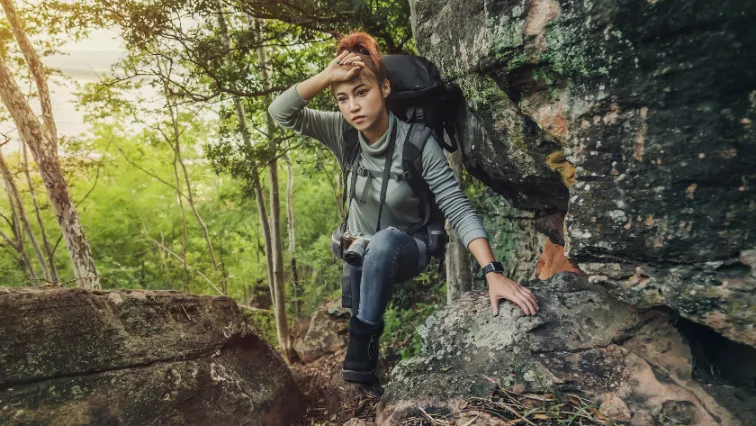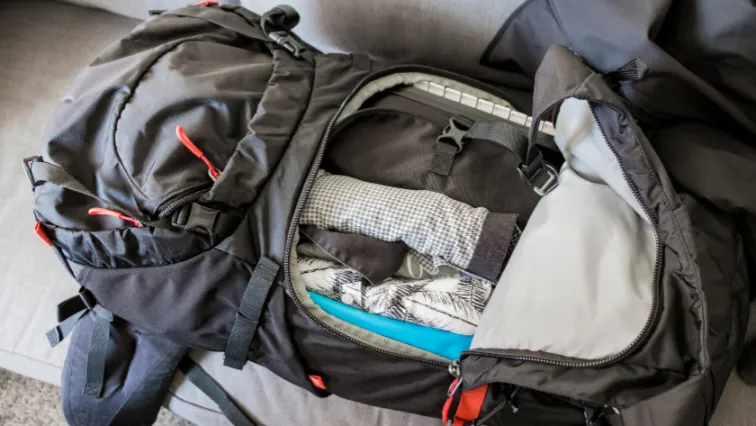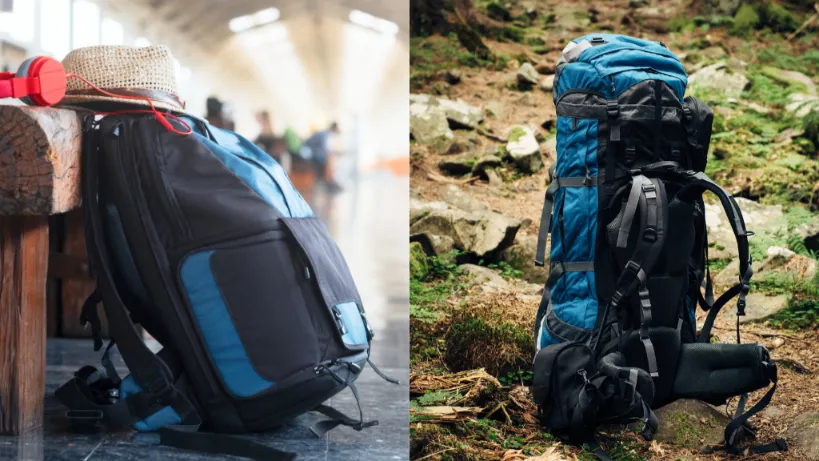The average daypack weighs 1.5 pounds, while the average multiday hiking backpack weighs 4.5 pounds.
That’s because modern hiking backpacks are made from lightweight materials such as nylon and polyester to reduce weight while maintaining durability.
However, the weight of a backpack can quickly add up with all the gear and supplies needed for a hike. So how much should hiking backpacks weigh, and what can you do to make them lighter?
In this article, I’ll explain why it’s important to pay attention to the weight of your hiking backpack, how much it should ideally weigh, and practical tips on lightening your load for a more enjoyable hiking experience.
How Much Should a Hiking Backpack Weigh?

Ideally, your hiking backpack should weigh no more than 3 pounds when empty, no matter if it’s a daypack or a multi-day trip backpack with a 30-60 liters capacity.
Also, make sure that your pack’s weight is no more than 20% of your body weight when it’s fully loaded. The reason behind this is that any heavier and you’ll be putting a lot of strain on your back, hips, legs, and feet. You’ll also tire out much quicker.
Seasoned hikers’ pack weights can range between 20-40% of a hiker’s body weight depending on how tough the trip is and how fit the hiker is. But remember, 40% is pushing it, so aim for the lower end if you can.
Day Hikes vs. Multi-Day Hikes
Your day pack might only need to be around 10 pounds when loaded, while for a multi-day adventure most hikers aim for a base weight under 30 pounds, with the real ultralight champs getting it under 10 pounds.
It’s all about what works for you though, as finding your own optimum pack weight is a personal discovery process.
How Do I Know If My Backpack Is Too Heavy?

Have you heard of the backpack syndrome? It’s not an official medical term, but it perfectly describes that aching feeling in your shoulders, neck, and back from carrying too much weight. If you’re feeling sore during or after a hike, that’s your body’s way of saying, “Hey, lighten up!”
Here’s how you can tell if your backpack is too heavy:
- The Struggle Is Real: If putting on your backpack feels like a workout, or if you’re huffing and puffing just from lifting it, that’s a red flag.
- Pain Points: Sore shoulders, strained back, or aching hips while you’re hiking? Your pack might be too hefty. A well-fitted, appropriately weighted pack shouldn’t cause pain.
- You’re Off-Balance: Ever felt like you’re going to tip over backwards while looking up at the sky? A too-heavy backpack can throw off your balance, making you more prone to falls.
- All the Adjustments: If you find yourself constantly adjusting the straps in a vain attempt to get comfortable, it’s probably not you – it’s the pack.
Now, how do you avoid the dreaded backpack syndrome? Here are a couple of tips:
- Weigh It: Before you head out, pop your fully packed backpack on a scale. A good rule of thumb is that it shouldn’t be more than 20% of your body weight. Less is even better. If you weigh 170 pounds, aim for a pack weight of 34 pounds or less.
- Pack Smart: Do you really need three books and a full-size pillow? Prioritize essentials and consider lighter alternatives for items you can’t leave behind.
- Check Your Fit: Make sure your backpack fits you properly. A well-adjusted pack distributes weight more evenly, reducing strain.
The goal is to enjoy your hike, not just endure it. Experiment with packing and adjust as needed.
How to Make Hiking Backpack Lighter? 4 Actionable Tips

#1 – Take a Good Look Inside Your Pack
Before you even think about stepping foot on that gorgeous trail, clear out some space and dump everything from your backpack onto it.
Now, with everything laid out, it’s time for some serious detective work. Ask yourself, “Do I really need to bring this?” for every single item. You’d be amazed at how much stuff we pack “just in case” ends up just taking a free ride on our backs.
Clothes
Preparing for every weather scenario seems smart, but do you really need four extra sweaters? Layering is key. Pick versatile items you can mix and match. And remember, you’ll be wearing one set of clothes, so you don’t need a full wardrobe change for each day.
Gear
Now, look at your gear. Your bulky sleeping bag might have sentimental value, but modern, lighter options could cut pounds off your pack weight. You also don’t need a full-size pillow. A small, inflatable one does the job just fine and saves a ton of space!
At the end, take a hard look at those “just in case” items. Ask yourself,“What’s the worst that could happen if I leave this behind?” If it’s not a matter of safety, you might want to reconsider packing it.
After this exercise, you should see a noticeable difference in your pack’s weight.
#2 – Trim the Fat
Before you look at your pack and start wondering if it’s been indulging in too many trail snacks, let me explain. By fat, I mean all extra bits and pieces like straps, buckles, and webbing that seem to just hang around without serving any real purpose.
Getting rid of these seemingly small parts can actually lighten your load substantially. I’m usually cutting up to 10% of my pack’s weight just because I get rid of these seemingly small parts.
It’s almost like losing the weight of three tennis balls from your pack!
But what if I need them? Well, if you haven’t used them by now, you likely won’t miss them. Of course, be smart about what you remove. If it’s critical for your pack’s structure or function, leave it be.
How to Start Trimming?
First, grab your pack and lay it out. Give it a good look and start identifying all extra straps and bits of webbing that have no clear purpose. Feel like a detective on a mission. Your goal is to find the unnecessary weight and eliminate it.
Next, get a pair of scissors or a seam ripper. Slowly and carefully, start removing these extras. Keep in mind, once they’re gone, there’s no turning back, so double-check before making any cuts.
After you’ve done the deed, weigh your pack. You’ll likely notice it’s become surprisingly lighter.
If you’re still unsure how to trim your backpack, see how Chris from ChrisGoesOutdoors saves 6.5 ounces just by trimming his Hyperlite Mountain Gear 2400!
#3 – Embrace Multi-Use Gear
That means items that can do double or even triple duty. Instead of bringing a separate pot, pan, and bowl, you can bring one lightweight item that can be all three.
Or instead of carrying both a heavy book for entertainment and a pillow for sleeping, why not bring an inflatable pillow that can also hold your smartphone up for some bedtime reading or star gazing apps?
One of my favorite examples is the humble bandana. It can be a:
- sweatband,
- dishcloth,
- napkin,
- makeshift bag,
- sun protection for your neck,
- a cool compress
- and so much more!
Another solid multi-use item is a good old spork – spoon and fork in one. Some even come with a knife edge. You’ll save space and weight, making your pack lighter and your life a bit simpler.
And my all-time favorite – duct tape. Need to fix a tear in your tent? Duct tape. Got a blister forming? Cover it with duct tape. Broken pole? Duct tape can hold it together until you get back.
Wrap some around your water bottle or trekking pole, and you’re good to go without carrying a whole roll.
Look at what you’re already packing and ask, “Can this item serve more than one purpose?” If not, is there something else that can? Always be on the lookout for versatile gear that fits your needs.
#4 – Food Planning
Food planning for hiking is about finding the right balance between nutrition, weight, and taste. It might take a bit of practice, but once you get the hang of it, you’ll be amazed at how much lighter your backpack feels.
Food That Fuels Without Weighing You Down
First things first, you want to focus on lightweight but high-energy foods. Think about stuff that packs a nutritional punch without taking up too much space or adding too much weight. Foods like nuts, dried fruits, and energy bars are perfect.
Dehydrated Meals
Have you tried dehydrated meals? I’ll admit, they might not win any gourmet food awards, but when you’re hungry and in the middle of nowhere, they taste pretty darn good!
They’re also super light and easy to pack. Just add hot water and dinner is served. You can find all sorts of flavors these days, so you’re bound to find something you like.
Plan and Portion
Before you even start packing, plan out each meal and snack. What will you eat for breakfast, lunch, and dinner? And what snacks do you need to keep you going?
Once you’ve got that sorted, portion everything out. This helps you avoid taking too much.
Say No to Extra Weight
Canned goods might seem like an easy option, but they’re heavy and take up too much space. The same goes for big packets of chips or any food with lots of water content. Stick to dry, compact options to save weight and space.
Water Wisdom
Water is essential, but it’s also heavy. Plan your route so you know where you can refill your water bottles. This way, you don’t have to carry more than you need.
Cook Smart
If you’re bringing a stove, think about how you can use it efficiently. Can you use the same pot for coffee and oatmeal? Can one meal’s boiling water be used to wash dishes afterwards? Little tricks like this save time and lighten your load.
Conclusion
The weight of our hiking backpacks is more than just numbers on a scale. It affects our energy levels, agility, and overall enjoyment of the trip.
When I first started hitting the trails, I didn’t give much thought to how heavy my pack was. I remember when I was weighing in at 167 pounds, with a backpack tipping the scales at 40-50 pounds!
It was way over what I should have been carrying. Only after discovering the 20% rule did I realize just how much easier it is to hike with a lighter load.
Have you checked how much your backpack weighs lately? Maybe it’s time to give it a go. You might just find that by shedding extra pounds from your pack, you’re also lifting a weight off your shoulders, allowing you to hike forward with ease.

Martha Heller
Hey there! I’m Martha, the face behind BigfootHiking.com – a blog I created alongside my husband Lukas. Originally from Phoenix, I’ve made hiking my life’s passion. With over 100 hikes under my belt in the past 7 years, and still counting, I’m always on the move. One of my proudest achievements was conquering Angel’s Landing in Zion National Park. When I’m not on the trails, you’ll find me tinkling on the piano or lost in my drawings. Drop by our blog for tips, tales, and plenty of trail inspiration!





